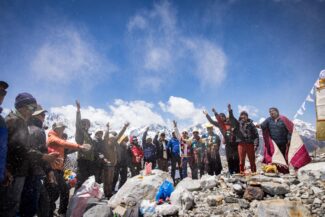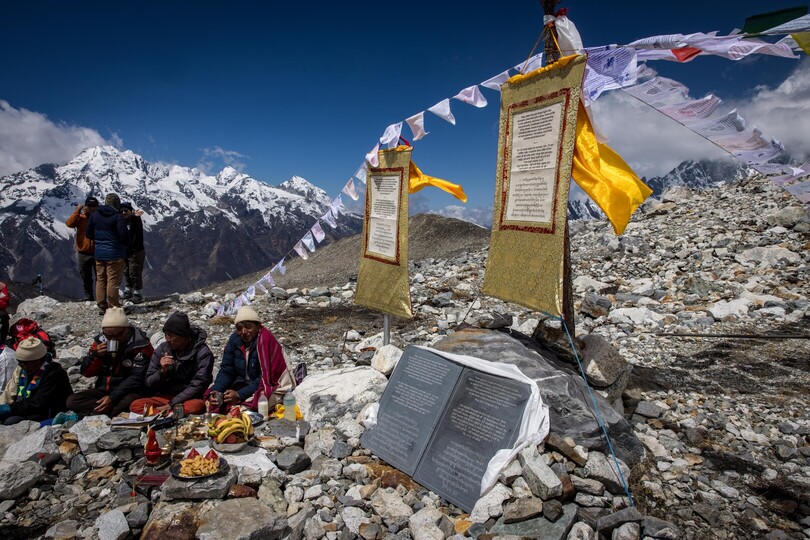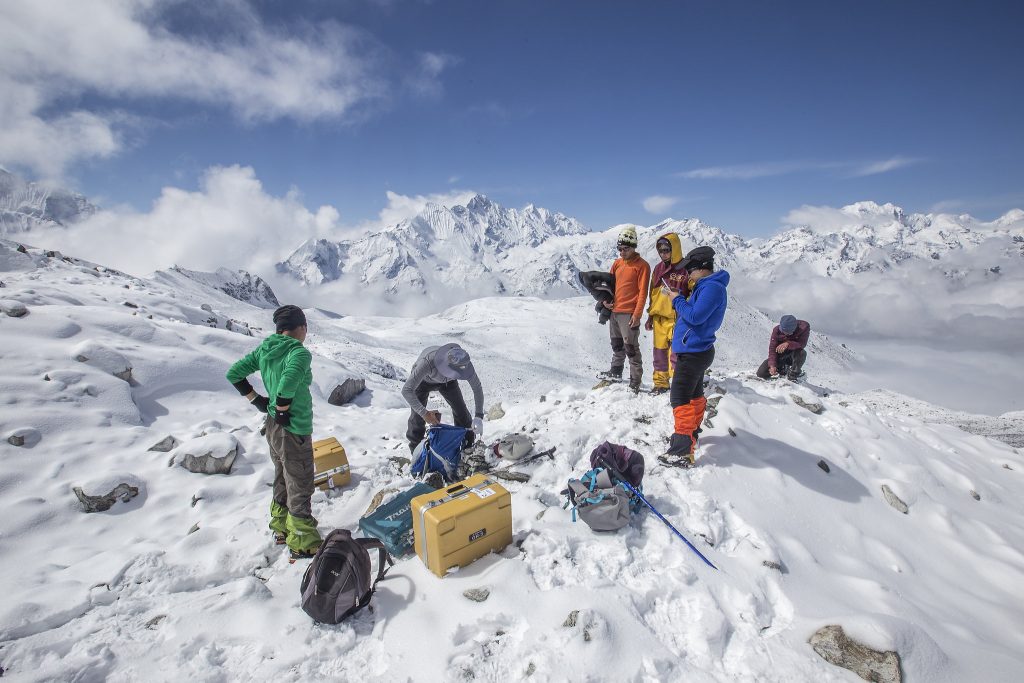On May 12, 2025, Buddha Day, Buddhist monks and scientific researchers gathered to pay tribute to Yala Glacier in Nepal’s Langtang Valley. The International Centre for Mountain Development (ICIMOD), an international NGO housed in Kathmandu, collaborated with local Indigenous community leaders to organize this event to raise awareness of Yala’s rapid retreat and highlight the risk across Hindu Kush Himalayan (HKH) glaciers. They invited community leaders, local university professors and international media to the tribute, which included a central ceremony held by spiritual leaders.
ICIMOD has often referred to the HKH region as the “pulse of the planet.” Extending across eight countries and pouring into 10 major river systems, HKH glaciers provide clean water for nearly 2 billion people. But now, Yala faces glacier death. A glacier can be declared dead when the movement of its ice has ceased: the glacier no longer flows. Yala is predicted to be the first glacier in Nepal to die.
Yala has shrunk 66 percent since 1974. Since ICIMOD began annual field work and training there in 2011, the glacier has retreated significantly, requiring researchers to move their original base camp. Studies predict that Yala will die by the 2040s.
Should that prediction hold true, Yala will join the ranks of other dead glaciers. In 2019, a ceremony was held for the Okjökull Glacier in Iceland. It was organized by anthropologists at Rice University, Cymene Howe and Dominic Boyer. A month after that first ceremony, Switzerland held a glacier memorial for the Pizol Glacier. Other glacier funerals have followed in Mexico, the United States and France. The ceremony at Yala, however, was a tribute.
According to Tribhuvan University sociologist Pasang Sherpa, the term “funeral” is out of place among the largely Tibetan Buddhist population. Sherpa told GlacierHub that community members intended the event as “a spiritual offering to honor the Yala Glacier to promote wellbeing and pray for the longevity of the glacier.”

Lamas (local spiritual leaders) made offerings of fruit, rice and milk. Sherpa said that “their role is crucial for this kind of ritual.” They prayed to “cleanse” the glacier, to purify the area and invite the gods to stay longer. Sharad Joshi, a glacier analyst at ICIMOD, told GlacierHub that climate change and pollution of Yala has been interpreted as defilement in a community where nature is held sacred.
In an interview with GlacierHub, ICIMOD’s Chimi Seldon said, “Yala is one of many peaks in this valley, considered by the locals as home to the gods…. Yala is very special. Its salt and water is considered medicinal. It’s said that if a yak grazes at its foothills, the food and milk is better.”
Many peoples around the world have believed in a connection between nature and the spiritual. “Throughout human history, people have understood their relationship with water, wind, fire and land in context of their relationship with God or with some divine being or beings,” said Karenna Gore, director of the Center for Earth Ethics, an affiliate center at the Columbia Climate School. This understanding and connection was present at the recent Yala tribute.
Some past glacier ceremonies have used religious rituals related to grief; some have been secular; and others have had a more direct political focus and message. Each inevitably marks an irreversible loss due to climate change. Many ceremonies have included one common element: placing a memorial plaque at the glacier site. Two such granite plaques containing poems were placed at Yala.

One poem was penned by Icelandic writer Andri Snaer Magnason. The same words appear on plaques at several former glacier sites in Iceland, Mexico, the Pyrenees and now, the Yala Glacier in Nepal: “We know what is happening and what needs to be done, only you know if we did it.”
In an interview with GlacierHub, Magnason expressed that the poem is “something that would echo in the mountains now absent of glaciers…maybe someone finds this after 1,000 years and connects the dots.” He said the memorial ceremonies were significant as a “cultural creation,” and an opportunity to “define historical moments” and mark loss in changing landscapes.
Manjushree Thapa, a Nepalese-born writer based in Canada, who spent years traveling throughout the Himalayan region, offered these lines: “Yala, where the gods dream high in the mountains, where the cold is divine…. Dream of a glacier and the civilizations downstream. Entire ecosystems: our own sustenance. The cosmos. And all that we know and all that we love.”
In addition to its spiritual elements, the ceremony was tied to the beginning of a new phase of field work for some scientists in attendance. Partners from nearby Tribhuvan and Kathmandu University were trained on site in glacier measurement methods alongside international colleagues. ICIMOD stated that the Yala Glacier “plays a crucial role in training glaciologists in the Himalayan region” and in research.

The collaboration in this ceremony between local community, scientists and international colleagues was a marked achievement of the tribute. Climate change is felt by the local community, with changing weather patterns, heavy rainfall and greater flood risk for an area already prone to flooding and landslides. As Thapa stated, “the communities who live in the forefront of climate change, are not themselves the cause…. Far richer, more industrialized countries are the culprits here.” Policy changes on an international level are necessary to fully address the issue of glacial recession and its immediate consequences, such as managing natural resources and emergency responses to natural disasters. The meaningful collaboration between experts and local communities conveyed at the memorial for Yala may help promote global shifts of this scale.
Source link
Guest news.climate.columbia.edu

